Productivity of Nitrogen Accumulated in Alfalfa–Grass Sward Cultivated on Soil Depleted in Basic Nutrients: A Case Study
Abstract
1. Introduction
2. Materials and Methods
2.1. Research Site
2.2. Weather Conditions
2.3. Experimental Design
- FGD gypsum (flue gas desulfurization) or synthetic gypsum—two levels (0 and 500 kg CaSO4 × 2H2O ha−1), referred to as GYP−0 and GYP−500;
- Phosphorus and potassium treatments—five levels, referred to as AC, P60K0, P60K30, P60K60, and P60K120.
2.4. Plant Sampling and Measurements
2.5. Calculated Parameters: Nutrient Unit Productivity—NUP
2.6. Statistical Analysis
3. Results
3.1. In-Season Variability in the Sward Yield
3.2. Nutrient Content in the Sward of Successive Cuts
3.3. Ratios between Pairs of Nutrients in the Alfalfa–Grass Sward
3.4. Nutrient Accumulation in the Alfalfa–Grass Sward
3.5. Utilization Efficiency of Nutrients Accumulated in the Alfalfa–Grass Sward
4. Discussion
4.1. Nutrient Content in the Alfalfa–Grass Sward and Yield
4.2. Nutrient Accumulation in the Sward and productivity
5. Conclusions
Supplementary Materials
Author Contributions
Funding
Institutional Review Board Statement
Informed Consent Statement
Data Availability Statement
Conflicts of Interest
Appendix A
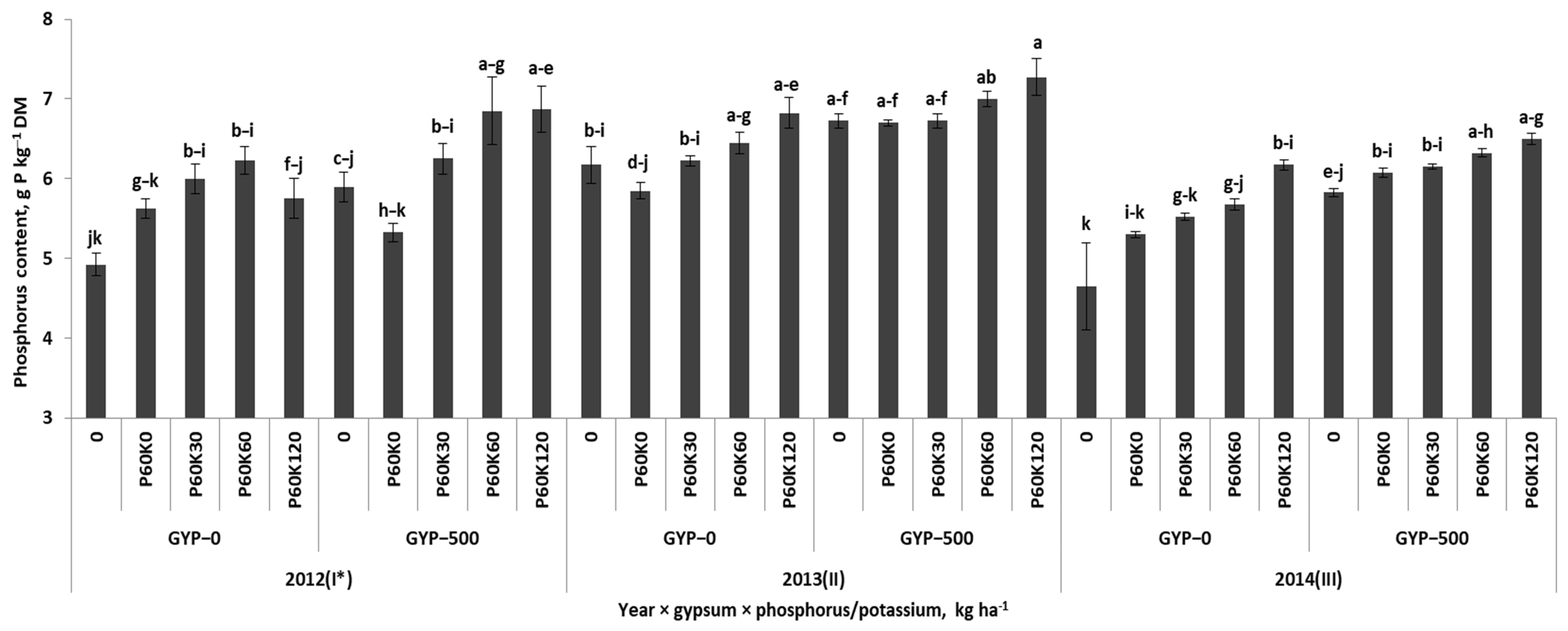

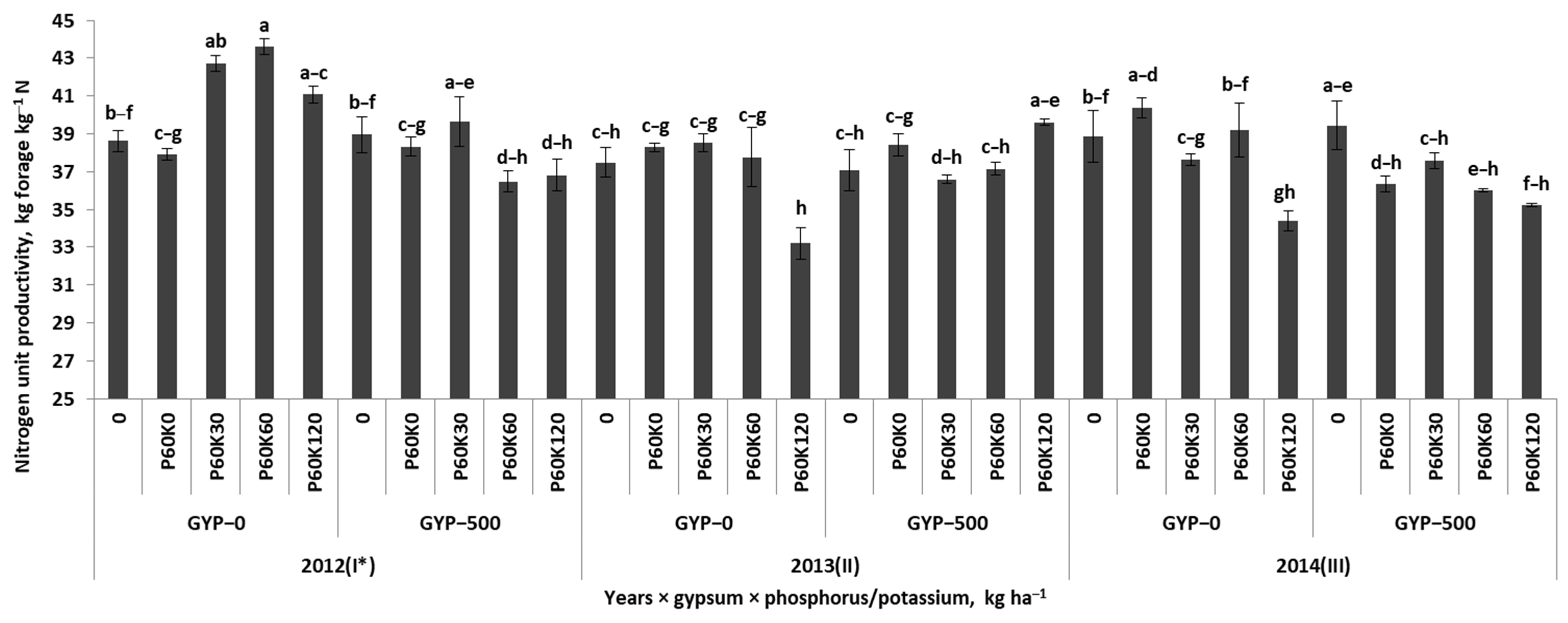
References
- McDonald, I.; Baral, R.; Min, D. Effects of alfalfa and alfalfa-grass mixtures with nitrogen fertilization on dry matter yield and forage nutritive value. J. Anim. Sci. Technol. 2021, 63, 305–318. [Google Scholar] [CrossRef] [PubMed]
- Peoples, M.B. Legumes root nitrogen in cropping system nitrogen cycling. Grain Legume 2001, 33, 8–9. [Google Scholar]
- Grzebisz, W.; Niewiadomska, A.; Przygocka-Cyna, K. Nitrogen hotspots on the farm—A practice-oriented approach. Agronomy 2022, 12, 1305. [Google Scholar] [CrossRef]
- Bork, E.W.; Gabruck, D.T.; McLeod, E.M.; Hall, L.M. Five-Year Forage Dynamics Arising from Four Legume–Grass Seed Mixes. Agron. J. 2017, 109, 2789–2799. [Google Scholar] [CrossRef]
- Fustec, J.; Lesuffleur, F.; Mahieu, S.; Cliquet, J.B. Nitrogen rhizodeposition of legumes. A review. Agron. Sustain. Dev. 2010, 30, 57–66. [Google Scholar] [CrossRef]
- Julier, B.; Gastal, F.; Louran, G.; Badenhausser, I.; Annichiarico, P.; Crocq, G.; Le Chaterlier, D.; Guillemot, E.; Emile, J.-C. Lucerne (alfalfa) in European Cropping Systems. In Legumes in Cropping Systems; Murphy-Bokern, D., Stoddard, F.L., Watson, C.A., Eds.; CPI Group (UK) Ltd.: Croydon, UK, 2017; pp. 168–192. [Google Scholar]
- Ojeda, J.J.; Caviglia, O.P.; Agnusdei, M.G.; Errecart, P.M. Forage yield, water-and solar radiation-productivities of perennial pastures and annual crops sequences in the south-eastern Pampas of Argentina. Field Crops Res. 2018, 221, 19–31. [Google Scholar] [CrossRef]
- Gierus, M.; Kleen, J.; Loges, R.; Taube, F. Forage legume species determine the nutritional quality of binary mixtures with perennial ryegrass in the first production year. Anim. Feed Sci. Technol. 2012, 172, 150–161. [Google Scholar] [CrossRef]
- Aponte, A.; Samarappuli, D.; Berti, M.T. Alfalfa–Grass Mixtures in Comparison to Grass and Alfalfa Monocultures. Agron. J. 2019, 111, 628–638. [Google Scholar] [CrossRef]
- Peeters, A.; Parente, G.; Le Gall, A. Temperate Legumes: Key-Species for Sustainable Temperate Mixtures. In Sustainable Grassland Productivity; Grassland Science in Europe; Artes Gráficas Marcipa: Badajoz, Spain, 2006. [Google Scholar]
- Harasim, J. Wpływ ilości wysiewu i doboru gatunków traw na produkcyjność mieszanek pastwiskowych z koniczyną białą na gruntach ornych. Pam. Puł. 2001, 126, 53–80. [Google Scholar]
- Gaweł, E. Ocena przydatności mieszanek lucerny z trawami do użytkowania pastwiskowego. Cz. I. Plonowanie i skład botaniczny. Pam. Puł. 2000, 121, 67–82. [Google Scholar]
- Hakl, J.; Fuksa, P.; Šantrůček, J.; Mášková, K. The development of lucerne root morphology traits under high initial stand density within a seven year period. Plant. Soil Environ. 2011, 57, 81–87. [Google Scholar] [CrossRef]
- Finn, J.A.; Kirwan, L.; Connolly, J.; Sebastià, M.T.; Helgadottir, A.; Baadshaug, O.H.; Bélanger, G.; Black, A.; Brophy, C.; Collins, R.P. Ecosystem function enhanced by combining four functional types of plant species in intensively managed grassland mixtures: A 3-year continental-scale field experiment. J. Appl. Ecol. 2013, 50, 365–375. [Google Scholar] [CrossRef]
- Bałuch, A.; Benedycki, S. Wpływ mieszanek motylkowato-trawiastych i nawożenia mineralnego na żyzność gleby. Ann. UMCS Sec. E 2004, 59, 441–448. [Google Scholar]
- Grzebisz, W.; Łukowiak, R. Nitrogen gap amelioration is a core for sustainable intensification of agriculture—A concept. Agronomy 2021, 11, 419. [Google Scholar] [CrossRef]
- Rice, W.A.; Penney, D.C.; Nyborg, M. Effect of soil acidity on rhizobia numbers, nodulation and nitrogen fixation by alfalfa and red clover. Can. J. Soil Sci. 1977, 57, 197–203. [Google Scholar] [CrossRef]
- Graham, P.H. Stress tolerance in Rhizobium and Bradyrhizobium, and nodulation under adverse soil conditions. Can. J. Microbiol. 1992, 38, 475–484. [Google Scholar] [CrossRef]
- Hájek, M.; Jiménez-Alfaro, B.; Hájek, O.; Brancaleoni, L.; Cantonati, M.; Carbognani, M.; Dedić, A.; Dítě, D.; Gerdol, R.; Hájková, P.; et al. A European map of groundwater pH and calcium. Earth Syst. Sci. Data 2021, 13, 1089–1105. [Google Scholar] [CrossRef]
- Granqvist, E.; Sun, J.; Op den camp, R.; Pujic, P.; Hill, L.; Normand, P.; Morris, R.J.; Downie, J.A.; Geurts, R.; Oldroyd, G.E.D. Bacterial-induced calcium oscillations are common to nitrogen-fixing associations of nodulating legumes and nonlegumes. New Phytol. 2015, 207, 551–558. [Google Scholar] [CrossRef] [PubMed]
- Thor, K. Calcium–Nutrient and messenger. Front. Plant Sci. 2019, 10, 440. [Google Scholar] [CrossRef]
- Lu, Y. Assembly and transfer of iron-sulfur clusters in the plastid. Front. Plant Sci. 2018, 9, 336. [Google Scholar] [CrossRef]
- Jamal, A.; Moon, Y.-S.; Abdin, M.Z. Sulphur—A general overview and interaction with nitrogen. Aust. J. Crop Sci. 2010, 4, 523–529. [Google Scholar]
- Maruyama-Nakashita, A.; Nakamura, Y.; Yamaya, T.; Takahashi, H. Regulation of high-affinity sulphate transporters in plants: Towards systematic analysis of Sulphur signalling and regulation. J. Exp. Bot. 2004, 55, 1843–1849. [Google Scholar] [CrossRef]
- Takahashi, H. Sulfate transport systems in plant: Functional diversity and molecular mechanisms underlying regulatory coordination. J. Exp. Bot. 2019, 70, 4075–4087. [Google Scholar] [CrossRef] [PubMed]
- Chen, L.; Dick, W.A. Gypsum as an agricultural amendment: General use guidelines. Bull. Ohio State Univ. 2011, 945, 36. [Google Scholar]
- Grzebisz, W.; Zielewicz, W.; Przygocka-Cyna, K. Deficiencies of secondary nutrients in crop plants—A real challenge to improve nitrogen management. Agronomy 2023, 13, 66. [Google Scholar] [CrossRef]
- Berg, W.K.; Cunningham, S.M.; Brouder, S.M.; Joern, B.C.; Johnson, K.D.; Santini, J.; Volenec, J.J. The long-term impact of phosphorus and potassium fertilization on alfalfa yield and yield components. Crop Sci. 2007, 47, 2198–2209. [Google Scholar] [CrossRef]
- Islam, M.A.; Baidoo, M.M. Effect of Potassium in Growth and Physiology of Alfalfa. In Handbook of Plant and Crop Physiology; Pessarakli, M., Ed.; CRC Press: London, UK, 2021; pp. 29–39. [Google Scholar]
- Macolino, S.; Lauriault, L.M.; Rimi, F.; Ziliotto, U. Phosphorus and potassium fertilizer effect on alfalfa and soil in non-limited soil. Agron. J. 2013, 105, 1613–1618. [Google Scholar] [CrossRef]
- Druille, M.; Deregibus, V.; Garbulsky, M.F. Environmental controls of Lucerne (Medicago sativa L.) growth across a climatic and edaphic gradient. Agriscientia 2017, 34, 2–13. [Google Scholar] [CrossRef]
- Wu, L.; Baddeley, J.; Watson, C. Models of biological fixation of legumes. A review. Agron. Sustain. Dev. 2011, 31, 155–172. [Google Scholar] [CrossRef]
- Ballabio, C.; Lugato, E.; Fernández-Ugalde, O.; Orgiazzi, A.; Jones, A.; Borelli, P.; Montanarella, L.; Panagos, P. Mapping LUCAS topsoil chemical properties at European scale using Gaussian process regression. Geoderma 2019, 355, 113912. [Google Scholar] [CrossRef]
- Zbíral, J.; Smatanová, M.; Němec, P. Sulphur status in agricultural soil determined using the Mehlich 3 method. Plant Soil Environ. 2018, 64, 255–259. [Google Scholar] [CrossRef]
- Panagos, P.; Köninger, J.; Ballabio, C.; Liakos, L.; Muntwyler, A.; Borelli, P.; Lugato, E. Improving the phosphorus budget of European agricultural soils. Sci. Total Environ. 2022, 853, 158706. [Google Scholar] [CrossRef] [PubMed]
- Pang, J.; Ryan, M.H.; Lambers, H.; Siddique, K.H.M. Phosphorus acquisition and utilization in crop legumes under global change. Curr. Opin. Plant Biol. 2018, 45, 248–254. [Google Scholar] [CrossRef]
- Zörb, C.; Senbayram, M.; Peiter, E. Potassium in agriculture—Status and perspectives. J. Plant Physiol. 2014, 171, 656–669. [Google Scholar] [CrossRef]
- Jungers, J.M.; Kaiser, D.E.; Lamb, J.F.S.; Lamb, J.A.; Noland, R.L.; Samac, D.A.; Wells, M.S.; Sheaffer, C.C. Potassium fertilization affects alfalfa forage yield, nutritive value, root traits, and persistence. Agron. J. 2019, 111, 2843–2852. [Google Scholar] [CrossRef]
- Zielewicz, W.; Swędrzyńska, D.; Swędrzyński, A.; Grzebisz, W.; Goliński, P. The Influence of Calcium Sulfate and Different Doses of Potassium on the Soil Enzyme Activity and the Yield of the Sward with a Mixture of Alfalfa and Grasses. Agriculture 2022, 12, 475. [Google Scholar] [CrossRef]
- Tirado-Corbalá, R.; Slater, B.K.; Dick, W.A.; Barker, D. Alfalfa responses to gypsum application measured using undisturbed soil columns. Plants 2017, 6, 29. [Google Scholar] [CrossRef] [PubMed]
- Kabała, C.; Charzyński, P.; Chodorowski, J.; Drewnik, M.; Glina, B.; Greinert, A.; Hulisz, P.; Jaknkowski, M.; Jonczak, J.; Łabaz, B.; et al. Polish Soil Classification: Principles, classification scheme and correlation. Soil Sci. Annu. 2019, 70, 71–97. [Google Scholar] [CrossRef]
- Mehlich, A. Mehlich 3 soil test extractant: A modification of Mehlich 2 extractant. Com. Soil Sci. Plant Anal. 1984, 15, 1409–1416. [Google Scholar] [CrossRef]
- Kęsik, K. Application of the Mehlich 3 method in the fertilizer advisory system. Stud. I Rap. IUNG-PIB 2016, 48, 95–104. (In Polish) [Google Scholar]
- Trávník, K.; Zbíral, J.; Němec, P. Agrochemical Soil Testing—Mehlich III; Central Institute for Supervising and Testing in Agriculture: Brno, Czech Republic, 1999; 101p. (In Czech) [Google Scholar]
- Porqueddu, C.; Meliss, R.A.M. Lucerne Crop in Drought-Prone Environment; CNR-SSPAAM: Portici, Italy, 2017; 17p. [Google Scholar]
- Bavec, F.; Bavec, M. Chlorophyll meter readings of winter wheat cultivars and grain yield prediction. Commun. Soil Sci. Plant Anal. 2022, 32, 2709–2719. [Google Scholar] [CrossRef]
- PN-EN ISO 20483:2014-02; Cereal Grains and Pulses—Determination of Nitrogen Content and Conversion to Crude Proteins—Kjeldahl Method. Polski Komitet Normalizacyjny: Warsaw, Poland, 2015; 24p.
- Gaweł, E.; Madej, A. Yield and economic assessment of the legume-grass mixtures depending on the system and frequency of their utilization and botanical composition. Acta Sci. Pol. Agric. 2008, 7, 53–63. [Google Scholar]
- Zoghlami, A. Preliminary results on the effect of seeding methods on production and botanical composition of perennial mixtures of alfalfa-grasses. In Legumes for Mediterranean Forage Crops, Pastures and Alternative Uses; Sulas, L., Ed.; Cahiers Options Méditerranéennes: Sassari, Italy, 2000; pp. 203–206. [Google Scholar]
- Vasileva, V.; Kostov, O. Effect of alfalfa grown for forage on soil fertility related to mineral and organic fertilization. Emir. J. Food Agric. 2015, 27, 678–686. [Google Scholar] [CrossRef]
- Coruh, I.; Tan, M. Lucerne persistence, yield and quality as influenced by stand aging. N. Z. J. Agric. Res. 2008, 51, 39–43. [Google Scholar] [CrossRef]
- Patel, P.C.; Kotecha, A.V. Effect of phosphorus and potassium on growth characters, forage yield, nutrient uptake and quality of lucerne (Medicago sativa L.). Indian J. Agron. 2006, 51, 242–244. [Google Scholar]
- Anglade, J.; Billen, G.; Garnier, J. Relationships for estimating N2 fixation in legumes: Incidence for N balance of legume-based cropping systems in Europe. Ecosphere 2015, 6, 1–24. [Google Scholar] [CrossRef]
- Wysokiński, A.; Kalmebasa, S.; Łozak, I. Dynamics of nitrogen accumulation from various sources of by Lucerne (Medicago sativa L.). Acta Sci. Oil. Agric. 2015, 14, 97–105. [Google Scholar]
- Issach, G.; Schoenau, J.J.; Lardner, H.A.; Knight, J.D. Nitrogen fixation and resource partitioning in alfalfa (Medicago sativa L.), cicer milkvetch (Astragalus cicer L.) and sainfoin (Onobrychis viciifolia Scop.) using 15N enrichment under controlled environment conditions. Agronomy 2020, 10, 1438. [Google Scholar] [CrossRef]
- Güsewell, S. N: P ratios in terrestrial plants: Variation and functional significance. New Phytol. 2004, 164, 243–266. [Google Scholar] [CrossRef]
- Wan, W.; Li, Y.; Li, H. Yield and quality of alfalfa (Medicago sativa L.) in response to fertilizer application in China: A meta-analysis. Front. Plant Sci 2022, 13, 1051725. [Google Scholar] [CrossRef]
- Barłóg, P.; Grzebisz, W.; Łukowiak, R. Fertilizers and fertilization strategies mitigating soil factors constraining efficiency of nitrogen in plant production. Plants 2022, 11, 1855. [Google Scholar] [CrossRef] [PubMed]
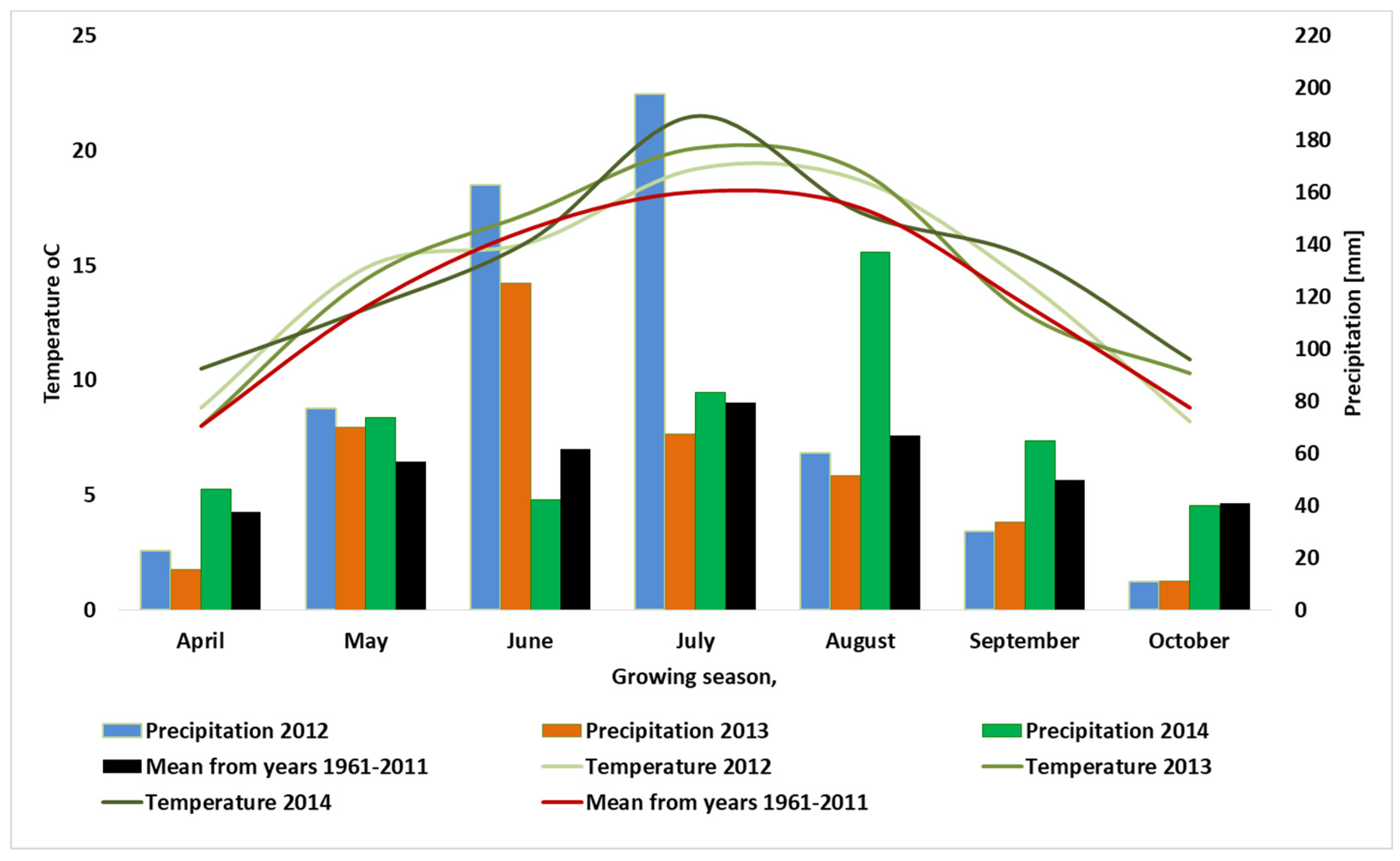
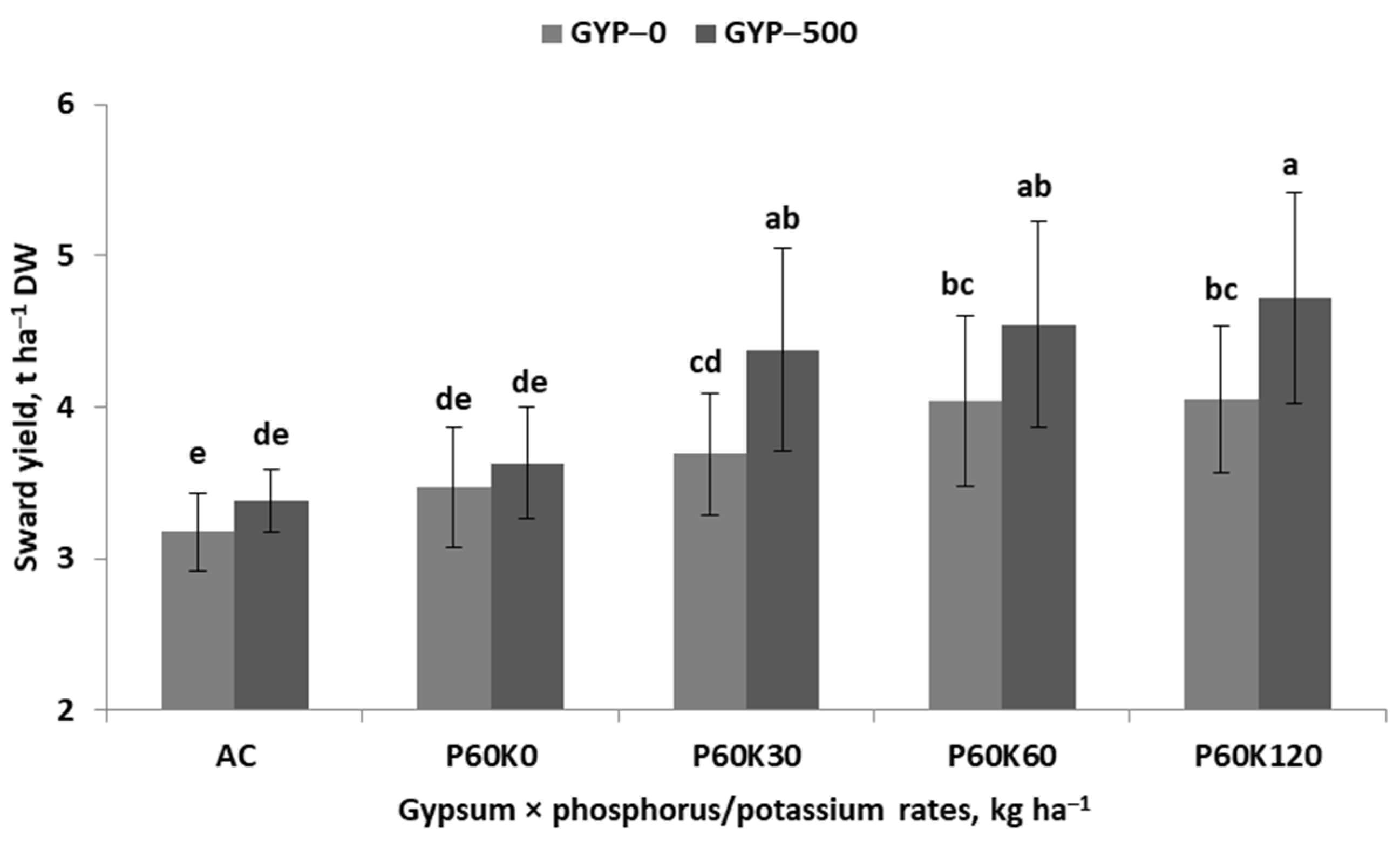
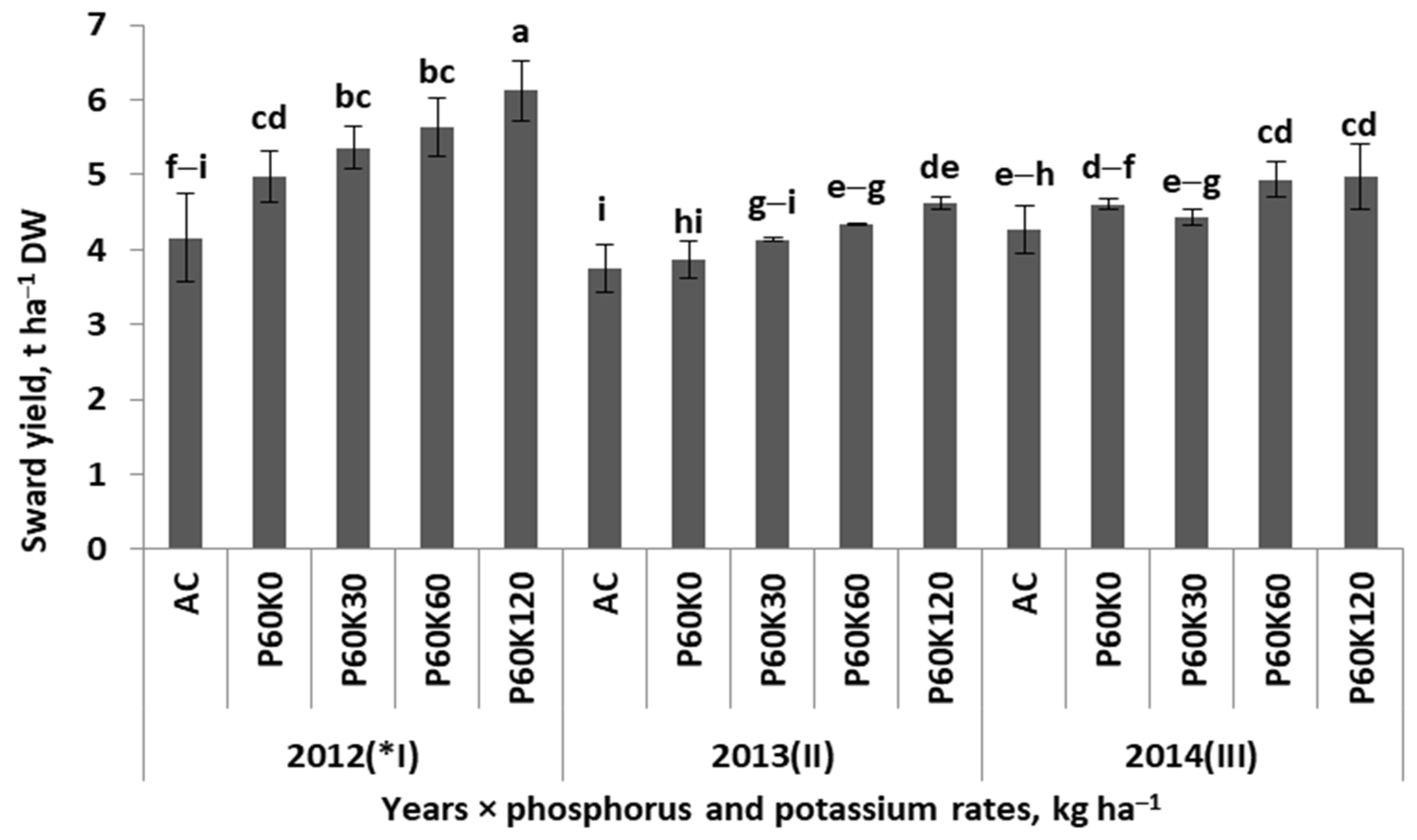
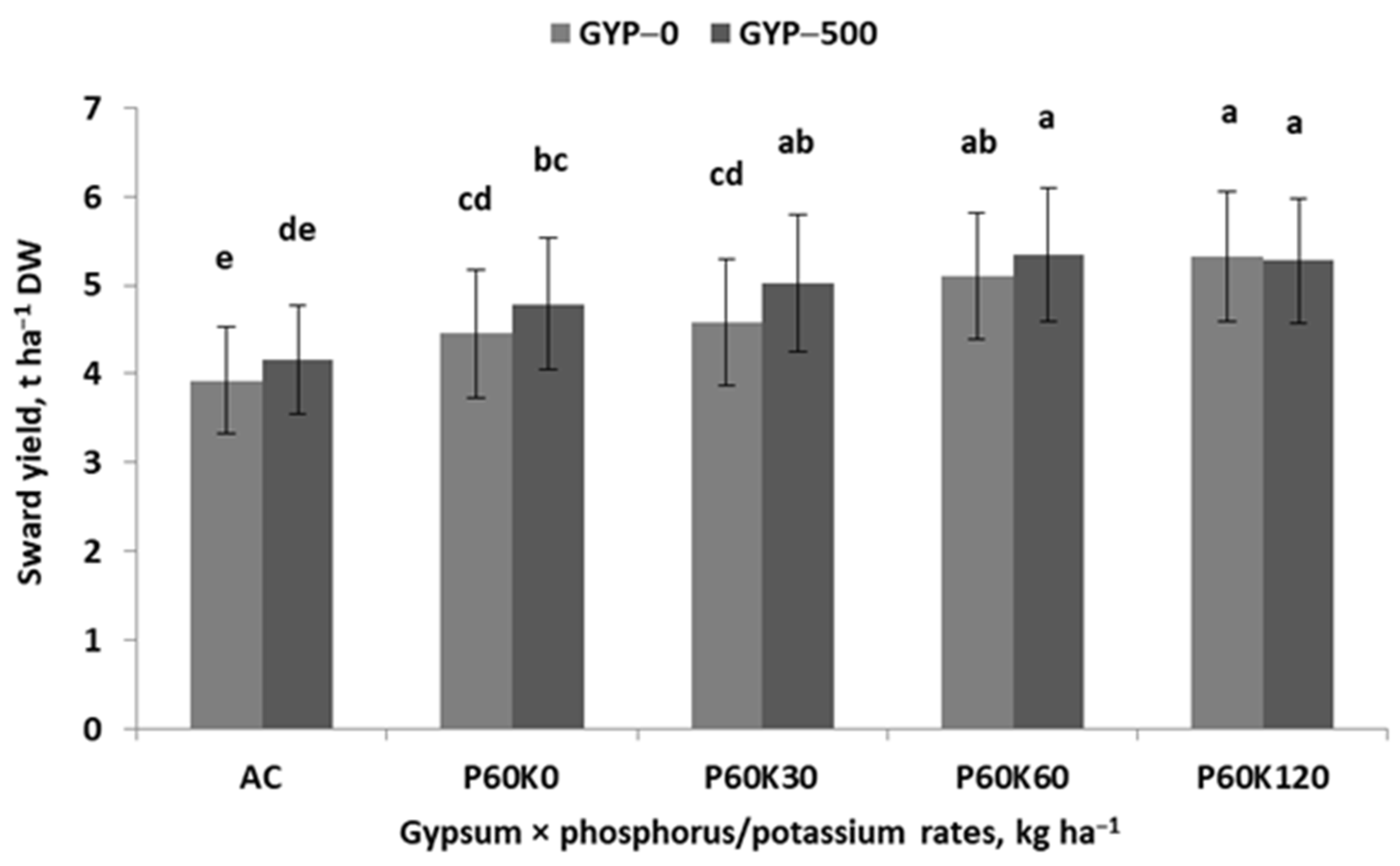
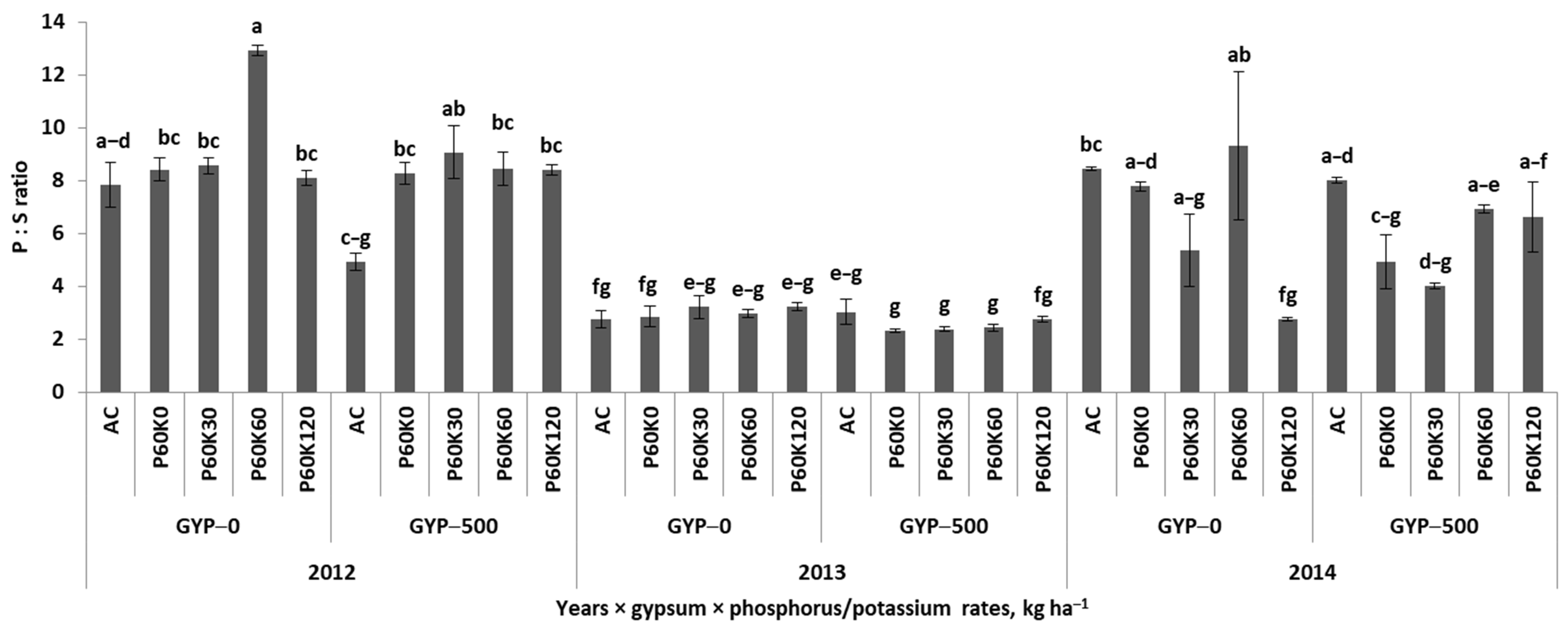
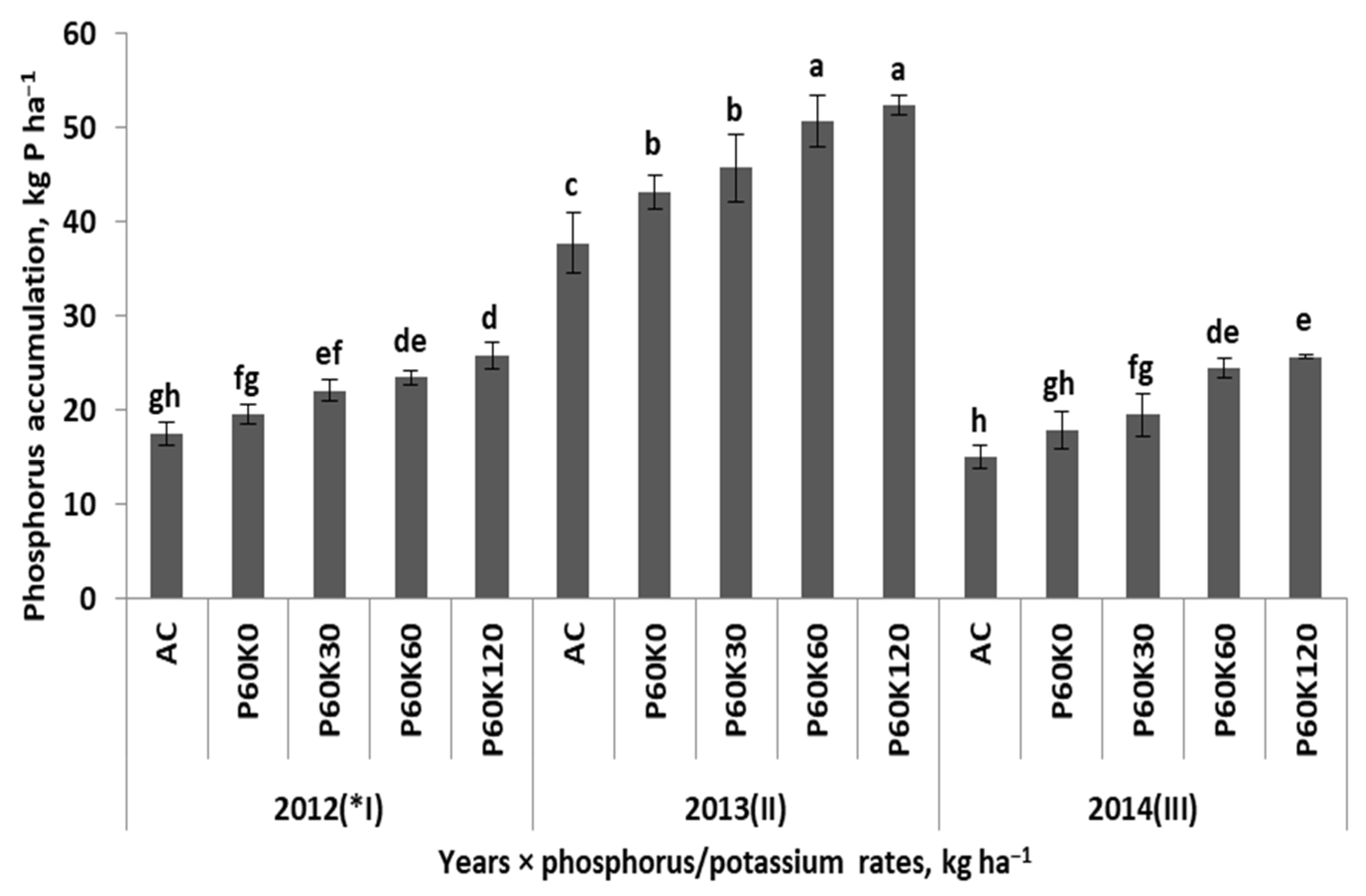
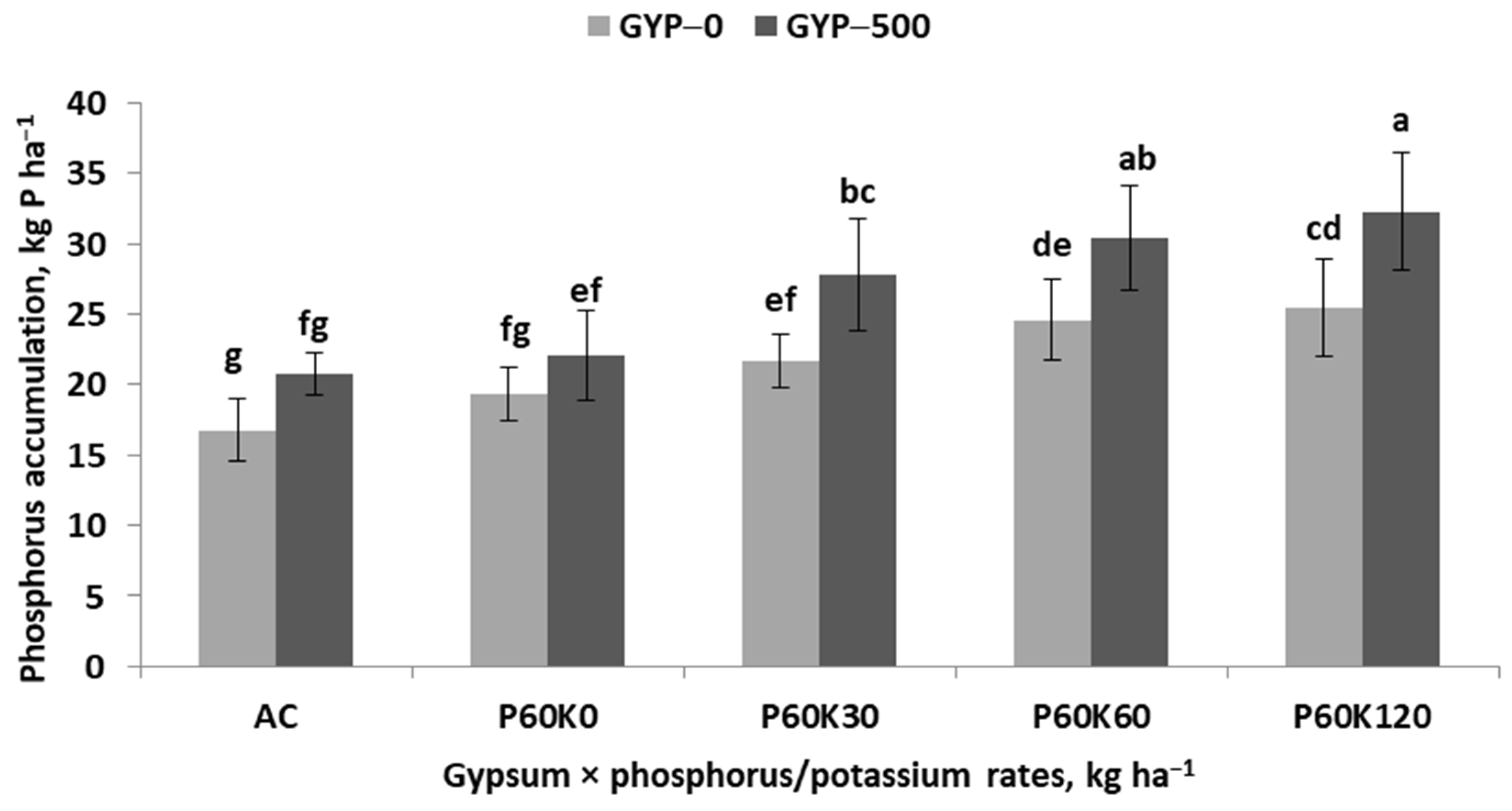
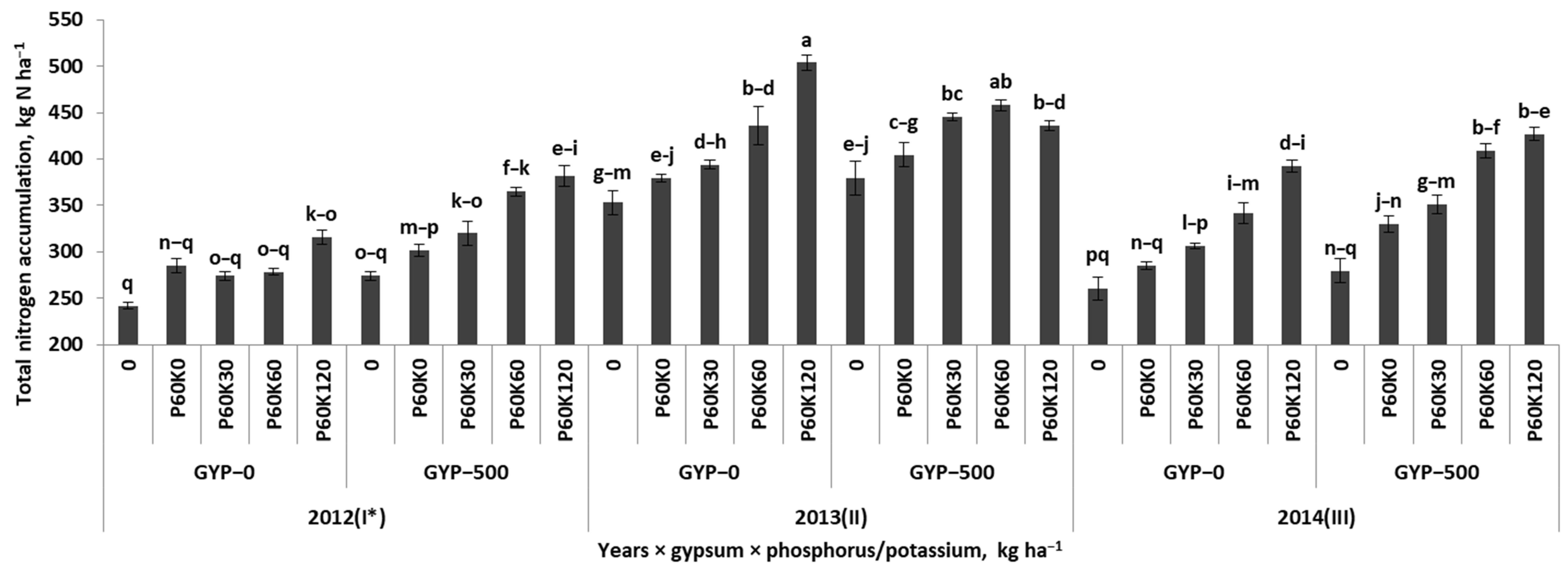
| Soil pH Nutrient | Soil Layer cm | Mean | SD | CV.% | Nutrient | Mean | SD | CV.% |
|---|---|---|---|---|---|---|---|---|
| pH 1 | 0−30 | 6.5 | 0.3 | 4.6 | K 4,5,7 | 88.2 L | 11.0 | 12.5 |
| 30−60 | 6.7 | 0.2 | 3.0 | mg kg−1 | 84.0 L | 12.9 | 15.4 | |
| 60−90 | 6.9 | 0.2 | 3.0 | P 4,5,7 | 63.5 L | 6.4 | 10.1 | |
| Humus 2 | 0−30 | 21.8 | 2.2 | 10.1 | mg kg−1 | 158.1 H | 5.4 | 3.4 |
| g kg−1 | 30−60 | 15.0 | 2.6 | 17.3 | 159.9 H | 6.6 | 4.1 | |
| 60−90 | 13.0 | 2.0 | 15.4 | 90.8 L | 15.6 | 17.1 | ||
| Total S 2 | 0−30 | 180 | 40 | 22.2 | Mg 4,5,8 | 164.0 VH | 11.2 | 6.8 |
| mg kg−1 | 30−60 | 210 | 40 | 19.0 | mg kg−1 | 191.5 VH | 61.1 | 31.9 |
| 60−90 | 240 | 90 | 37.5 | 140.5 VH | 39.1 | 27.8 | ||
| S-SO4 4 | 0−30 | 5.2 VL 4,5,6 | 0.9 | 17.3 | Ca 4,5,8 | 690.4 VL | 121.1 | 17.5 |
| mg kg−1 | 30−60 | 7.0 VL | 0.7 | 10.0 | mg kg−1 | 674.9 VL | 17.5 | 2.6 |
| 60−90 | 8.9 VL | 1.1 | 12.4 | 450.7 VL | 38.5 | 8.5 |
| Factor | Factor | TY | Y1 | Y2 | Y3 | N1 | N2 | N3 | SPAD1 | SPAD2 | SPAD3 | Alfalfa | Grass |
|---|---|---|---|---|---|---|---|---|---|---|---|---|---|
| Level | t ha−1 DW | g kg−1 DM | - | % | % | ||||||||
| Year | 2012 | 11.9 c | 3.1 c | 5.3 a | 3.5 b | 25.2 b | 24.4 b | 27.4 b | 652.0 b | 646.1 b | 622.2 a | 75.3 b | 19.8a |
| (Y) | 2013 | 15.6 a | 3.9 b | 4.1 c | 7.6 a | 28.1 a | 29.7 a | 24.6 b | 698.2 a | 632.7 c | 607.3 b | 78.5 b | 14.1b |
| 2014 | 12.6 b | 4.7 a | 4.6 b | 3.2 c | 24.1 b | 24.7 b | 33.6 a | 628.8 c | 675.9 a | 572.8 c | 83.6 a | 6.9c | |
| p | *** | *** | *** | *** | *** | *** | *** | *** | *** | *** | ** | *** | |
| FGD (GYP) | 0 | 12.9 b | 3.7 b | 4.5 b | 4.7 b | 25.1 b | 25.6 b | 28.8 | 653.8 b | 649.0 b | 600.4 b | 78.5 | 13.8a |
| kg ha−1 | 500 | 13.9 a | 4.1 a | 4.9 a | 4.9 a | 26.5 a | 27.0 a | 28.3 | 665.5 a | 654.1 a | 601.0 a | 79.8 | 11.8b |
| p | *** | *** | *** | *** | *** | *** | ns | *** | *** | *** | ns | ** | |
| PK | A C | 11.4e | 3.3 d | 4.1 d | 4.0 c | 25.4 | 26.2 b | 28.1 b | 648.4 c | 639. c | 581.7 d | 78.3 ab | 13.6a |
| Fertilization | P60K0 | 12.7 d | 3.5 c | 4.5 c | 4.6 b | 25.6 | 26.3 ab | 28.3 b | 651.8 c | 639.9 c | 588.0 c | 75.8 b | 14.2a |
| (POT) | P60K30 | 13.5 c | 4.0 b | 4.6 c | 4.8 b | 25.6 | 26.3 ab | 27.7 b | 657.9 b | 650.7 b | 594.0 b | 79.2 ab | 13.2a |
| kg ha−1 | P60K60 | 14.5 b | 4.3 a | 5.0 b | 5.2 a | 26.0 | 25.7 ab | 28.8 ab | 669.3 a | 662.3 a | 620.6 a | 82.3 b | 9.3b |
| P60K120 | 14.9 a | 4.4 a | 5.2 a | 5.3 a | 26.4 | 26.8 a | 29.8 a | 670.8 a | 665.4 a | 619.3 a | 80.2 ab | 13.6a | |
| p | *** | *** | *** | *** | ns | * | *** | *** | *** | ns | * | * | |
| Source of variation of the studied interactions | |||||||||||||
| Y × GYP | ns | ** | ** | ns | ns | *** | *** | ns | ns | *** | ns | * | |
| Y × POT | ns | *** | *** | *** | ** | *** | *** | ns | ** | *** | * | ** | |
| GYP × POT | ns | ** | ns | * | ns | *** | ** | ns | *** | ** | ns | * | |
| Y × GYP × POT | ns | ns | ns | ns | * | *** | *** | ns | ** | *** | ns | *** | |
| Mean | 13.4 | 3.9 | 4.7 | 4.8 | 25.8 | 26.3 | 28.5 | 659.7 | 651.6 | 600.7 | 84.8 | 13.6 | |
| Standard deviation | 2.2 | 0.9 | 0.7 | 2.1 | 2.3 | 3.0 | 4.2 | 22.3 | 22.3 | 34.5 | 2.9 | 5.8 | |
| Coefficient of variation, % | 16.2 | 22.5 | 14.7 | 43.7 | 9.1 | 9.1 | 14.8 | 4.8 | 3.4 | 5.7 | 3.4 | 42.5 | |
| Factor | Factor | C1 | C2 | C3 | P1 | P2 | P3 | S1 | S2 | S3 |
|---|---|---|---|---|---|---|---|---|---|---|
| Level | g kg−1 DM | |||||||||
| Year | 2012 | 459 a | 458 a | 446 a | 6.0 b | 6.6 a | 6.1 b | 1.7 b | 2.0 a | 0.8 c |
| (Y) | 2013 | 443 b | 441 b | 432 b | 6.6 a | 6.7 a | 6.0 b | 0.8 c | 2.3 a | 2.2 a |
| 2014 | 430 c | 438 c | 421 c | 5.8 b | 5.8 b | 6.3 a | 2.7 a | 2.0 a | 1.2 b | |
| p | *** | *** | *** | *** | *** | *** | *** | ns | *** | |
| FGD (GYP) | 0 | 449 a | 449 a | 436 a | 5.8 b | 6.1 b | 5.9 b | 1.4 b | 1.8 b | 1.3 b |
| kg ha−1 | 500 | 439 b | 442 b | 429 b | 6.4 a | 6.6 a | 6.3 a | 2.0 a | 2.3 a | 1.5 a |
| p | *** | *** | *** | *** | *** | *** | *** | ** | *** | |
| PK | A C | 454 a | 451 a | 443 a | 5.7 c | 6.0 c | 5.8 d | 1.5 | 2.3 | 1.3 b |
| Fertilization | P60K0 | 443 b | 449 ab | 429 b c | 5.8 c | 6.0 c | 5.8 d | 1.6 | 2.1 | 1.4 ab |
| (POT) | P60K30 | 444 b | 442 b | 433 b | 6.1 b | 6.3 b | 6.1 c | 1.7 | 1.7 | 1.5 ab |
| kg ha−1 | P60K60 | 438 b | 446 ab | 426 c | 6.4 ab | 6.8 a | 6.3 b | 1.6 | 2.1 | 1.3 b |
| P60K120 | 440 b | 441 b | 432 b c | 6.6 a | 6.8 a | 6.6 a | 2.3 | 2.1 | 1.6 a | |
| p | *** | ** | *** | *** | *** | *** | ns | ns | ** | |
| Source of variation of the studied interactions | ||||||||||
| Y × GYP | ns | ns | ns | ns | * | ns | ** | * | ** | |
| Y × POT | * | ** | *** | * | ** | *** | * | ns | *** | |
| GYP × POT | ** | ns | * | ns | ns | ns | ns | * | ** | |
| Y × GYP × POT | *** | *** | *** | * | * | ns | ns | ** | *** | |
| Mean | 444 | 446 | 433 | 6.1 | 6.4 | 6.1 | 1.7 | 2.1 | 1.4 | |
| Standard deviation | 16.3 | 23.8 | 14.2 | 0.6 | 0.6 | 0.4 | 1.1 | 0.8 | 0.7 | |
| Coefficient of variation, % | 3.7 | 3.1 | 3.3 | 10.1 | 9.9 | 6.5 | 65.1 | 36.3 | 51.3 | |
| Factor | Factor | NP−1 | NP−2 | NP−3 | NS−1 | NS−2 | NS−3 | PS−1 | PS−2 | PS−3 |
|---|---|---|---|---|---|---|---|---|---|---|
| Level | ||||||||||
| Year | 2012 | 4.3 | 3.7 c | 4.5 b | 23.1 b | 15.3 b | 38.3 a | 5.4 b | 4.2 ab | 8.5 a |
| (Y) | 2013 | 4.3 | 4.5 a | 4.1 c | 39.2 a | 15.2 b | 11.5 b | 9.2 a | 3.3 b | 2.8 c |
| 2014 | 4.2 | 4.3 b | 5.4 a | 8.9c | 20.8 a | 34.8 a | 2.2 c | 4.8 a | 6.4 b | |
| p | ns | *** | *** | *** | * | *** | ** | *** | *** | |
| FGD (GYP) | 0 | 4.4 a | 4.2 a | 4.9 a | 27.2 a | 20.9 a | 31.0 a | 6.3 a | 5.0 a | 6.3 a |
| kg ha−1 | 500 | 4.1 b | 4.1 b | 4.5 b | 20.3 b | 13.3 b | 25.4 b | 4.9 b | 3.3 b | 5.5 b |
| p | ** | *** | *** | *** | *** | *** | *** | *** | *** | |
| PK | AC | 4.5 a | 4.4 a | 4.9 a | 21.2 b | 19.8 ab | 30.0 ab | 4.7 b | 4.6 ab | 5.8 b |
| Fertilization | P60K0 | 4.4 ab | 4.4 a | 4.9 a | 24.6 ab | 14.3 b | 29.0 a–c | 5.6 ab | 3.2 b | 5.8 b |
| (POT) | P60K30 | 4.2 bc | 4.2 b | 4.5 b | 24.1 ab | 22.2 a | 24.8 bc | 5.6 ab | 5.2 a | 5.4 b |
| kg ha−1 | P60K60 | 4.0 c | 3.8 c | 4.5 b | 27.3 a | 13.9 b | 33.6 a | 6.7 a | 3.9 ab | 7.2 a |
| P60K120 | 4.0 c | 4.0 c | 4.5 b | 21.4 b | 15.3 ab | 23.6 c | 5.3 b | 3.7 ab | 5.3 b | |
| p | *** | *** | *** | ** | * | *** | * | * | ** | |
| Source of variation of the studied interactions | ||||||||||
| Y × GYP | ns | *** | ** | *** | ns | ns | *** | ns | ns | |
| Y × POT | ** | ** | *** | *** | ns | *** | * | ns | *** | |
| GYP × POT | ** | *** | *** | ns | * | ** | ns | * | ** | |
| Y × GYP × POT | ns | *** | *** | * | ns | ** | * | ns | ** | |
| Factor | Factor | C1a | C2a | C3a | N1a | N2a | N3a | P1a | P2a | P3a | S1a | S2a | S3a |
|---|---|---|---|---|---|---|---|---|---|---|---|---|---|
| Level | t ha−1 | kg ha−1 | |||||||||||
| Year | 2012 | 1.432 c | 2.404 a | 1.576 b | 78.7 c | 128.0 a | 97.0 c | 18.8 c | 34.8 a | 21.7 b | 5.4 b | 10.4 | 2.7 c |
| (Y) | 2013 | 1.708 b | 1.824 c | 3.283 a | 108.7 b | 123.0 b | 187.3 a | 25.6 b | 27.7 b | 45.9 a | 2.9 c | 9.5 | 17.1 a |
| 2014 | 2.032 a | 2.033 b | 1.361 c | 115.0 a | 115.0 c | 109.2 b | 28.0 a | 27.1 b | 20.5 c | 13.1 a | 9.2 | 4.0 b | |
| p | *** | *** | *** | *** | *** | *** | *** | *** | *** | *** | ns | *** | |
| FGD (GYP) | 0 | 1.644 b | 2.026 b | 2.040 b | 92.7 b | 113.6 b | 130.2 | 21.5 b | 27.5 b | 27.7 b | 5.6 b | 8.0 b | 7.1 b |
| kg ha−1 | 500 | 1.804 a | 2.148 a | 2.106 a | 108.9 a | 130.4 a | 132.1 | 26.7 a | 32.2 a | 31.0 a | 8.7 a | 11.4 a | 8.8 a |
| p | *** | *** | ** | *** | *** | ns | *** | *** | *** | *** | *** | *** | |
| PK | AC | 1.484 c | 1.828 c | 1.799 c | 83.3 c | 105.8s | 108.9 d | 18.8 d | 24.2e | 23.4e | 5.2 b | 9.4 | 6.2 c |
| Fertilization | P60K0 | 1.567 c | 2.017 b | 1.985 b | 90.7 c | 116.9 c | 123.6 c | 20.7 c | 26.9 d | 26.8 d | 6.0 b | 9.6 | 7.7 b |
| (POT), kg ha−1 | P60K30 | 1.779 b | 2.054 b | 2.080 b | 103.2 b | 120.9 b c | 126.0 c | 24.8 b | 29.1 c | 29.0 c | 7.2 b | 8.0 | 8.1 ab |
| P60K60 | 1.871 ab | 2.220 a | 2.220 a | 110.7 ab | 127.0 b | 143.6 b | 27.5 a | 33.7 b | 32.8 b | 7.4 ab | 10.5 | 8.4 ab | |
| P60K120 | 1.919 a | 2.314 a | 2.282 a | 116.2 a | 139.5 a | 153.7 a | 28.8 a | 35.4 a | 34.6 a | 10.0 b | 10.9 | 9.2 a | |
| p | *** | *** | *** | *** | *** | *** | *** | *** | *** | *** | ns | *** | |
| Source of variation of the studied interactions | |||||||||||||
| Y × GYP | ** | * | ns | ns | *** | *** | ** | ns | ** | * | * | *** | |
| Y × POT | ** | ** | * | *** | * | *** | *** | *** | *** | ** | ns | *** | |
| GYP × POT | ** | ns | *** | ns | *** | *** | * | * | ns | * | * | * | |
| Y × GYP × POT | ns | * | ** | ns | ** | *** | ns | ns | ns | ns | ** | * | |
| Mean | 1.724 | 2.087 | 2.073 | 100.8 | 122.0 | 131.2 | 24.1 | 29.9 | 29.3 | 7.2 | 9.7 | 7.9 | |
| Standard deviation | 0.338 | 0.325 | 0.897 | 23.7 | 17.6 | 45.7 | 6.4 | 6.3 | 12.8 | 5.5 | 3.6 | 6.9 | |
| Coefficient of variation. % | 19.6 | 15.6 | 43.3 | 23.5 | 14.4 | 34.8 | 26.7 | 21.1 | 43.6 | 76.7 | 37.3 | 87.6 | |
| Factor | Factor | TC | TN | TP | TS | CUP | NUP | PUP | SUP |
|---|---|---|---|---|---|---|---|---|---|
| Level | t ha−1 | kg ha−1 | kg Fodder DW kg−1 Nutrient | ||||||
| Year | 2012 | 3.917 b | 303.8 c | 75.3 b | 18.5 c | 3.0 b | 39.4 a | 160.2 b | 4691 a |
| (Y) | 2013 | 3.623 c | 418.9 a | 99.1 a | 29.5 a | 4.3 a | 37.4 b | 158.8 b | 956 c |
| 2014 | 4.519 a | 338.3 b | 75.3 b | 26.0 b | 2.6 c | 37.5 b | 169.8 a | 4086 b | |
| p | *** | *** | *** | *** | *** | *** | *** | *** | |
| FGD (GYP) | 0 | 3.755 b | 336.5 b | 76.7 b | 20.7 b | 3.4 a | 38.6 a | 169.7 a | 3527 a |
| kg ha−1 | 500 | 4284.9 a | 370.8 a | 89.8 a | 28.6 a | 3.2 b | 37.6 b | 156.2 b | 2961 b |
| p | *** | *** | *** | *** | *** | *** | *** | *** | |
| PK | AC | 3.408 d | 298.0 e | 66.4 e | 20.9 c | 3.4 a | 38.4 a | 173.8 a | 3515 ab |
| Fertilization | P60K0 | 3.672 c | 331.1 d | 74.4 d | 23.3 b c | 3.5 a | 38.3 a | 170.9 a | 3338 b |
| (POT) | P60K30 | 4.031 b | 348.6 c | 82.7 c | 22.7 b c | 3.2 a | 38.8 a | 163.3 b | 2957 b c |
| kg ha−1 | P60K60 | 4.416 a | 381.2 b | 94.0 b | 26.3 ab | 3.3 a | 38.4 a | 154.8 c | 3765 a |
| P60K120 | 4572 a | 409.4 a | 98.8 a | 30.1 a | 3.2 a | 36.7 b | 151.7 c | 26,445 c | |
| p | *** | *** | *** | *** | * | *** | *** | *** | |
| Source of variation of the studied interactions | |||||||||
| Y × GYP | *** | *** | ns | ** | *** | *** | * | ns | |
| Y × POT | *** | *** | ns | ns | *** | *** | *** | *** | |
| GYP × POT | *** | ** | ns | * | *** | *** | * | *** | |
| Y × GYP × POT | *** | *** | ns | ns | *** | *** | ns | *** | |
| Mean | 4.020 | 353.7 | 83.2 | 24.7 | 3.3 | 38.1 | 162.9 | 3244 | |
| Standard deviation | 0.761 | 68.1 | 18.0 | 8.0 | 0.09 | 2.2 | 12.8 | 1956 | |
| Coefficient of variation, % | 18.9 | 19.2 | 21.7 | 32.3 | 25.7 | 5.7 | 7.9 | 60.3 | |
Disclaimer/Publisher’s Note: The statements, opinions and data contained in all publications are solely those of the individual author(s) and contributor(s) and not of MDPI and/or the editor(s). MDPI and/or the editor(s) disclaim responsibility for any injury to people or property resulting from any ideas, methods, instructions or products referred to in the content. |
© 2023 by the authors. Licensee MDPI, Basel, Switzerland. This article is an open access article distributed under the terms and conditions of the Creative Commons Attribution (CC BY) license (https://creativecommons.org/licenses/by/4.0/).
Share and Cite
Zielewicz, W.; Grzebisz, W.; Przygocka-Cyna, K.; Goliński, P. Productivity of Nitrogen Accumulated in Alfalfa–Grass Sward Cultivated on Soil Depleted in Basic Nutrients: A Case Study. Agronomy 2023, 13, 1765. https://doi.org/10.3390/agronomy13071765
Zielewicz W, Grzebisz W, Przygocka-Cyna K, Goliński P. Productivity of Nitrogen Accumulated in Alfalfa–Grass Sward Cultivated on Soil Depleted in Basic Nutrients: A Case Study. Agronomy. 2023; 13(7):1765. https://doi.org/10.3390/agronomy13071765
Chicago/Turabian StyleZielewicz, Waldemar, Witold Grzebisz, Katarzyna Przygocka-Cyna, and Piotr Goliński. 2023. "Productivity of Nitrogen Accumulated in Alfalfa–Grass Sward Cultivated on Soil Depleted in Basic Nutrients: A Case Study" Agronomy 13, no. 7: 1765. https://doi.org/10.3390/agronomy13071765
APA StyleZielewicz, W., Grzebisz, W., Przygocka-Cyna, K., & Goliński, P. (2023). Productivity of Nitrogen Accumulated in Alfalfa–Grass Sward Cultivated on Soil Depleted in Basic Nutrients: A Case Study. Agronomy, 13(7), 1765. https://doi.org/10.3390/agronomy13071765








